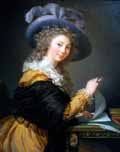 June 5 - August 8, 1982
|
|
| ||||||||||||||||||
(? THE COMTESSE DE CERES) Oil on canvas: 363/4 x 293/8 inches, (93.3 x 74.5 cm.) Signed and dated on the letter: L V Le Brun / 1784 The Toledo Museum of Art; Gift of Edward Drummond Libbey With its descriptive rendering of textural detail and its dazzling color scheme, this picture typifies the "lush images" (Conisbee, cited below) which Vigee Le Brun's contemporaries found so delectable. In an article published in the Gazette des Beaux-Arts (Baillio, cited below), I argued that Toledo's painting may have figured in the artist's catalogue as "Une jeune fille qui ecrit et que l'on surprend" (A Young Girl Surprised While Writing) (Souvenlilrs L, 338). Upon reflection, I mvself have come to challenge the plausibility of this hypothesis. The subject is obviously not a girl but a mature woman.
The names of only two women appear in the short list of sitters for the vear in question. The first is the Comtesse de Grammont- Caderousse, whose portrait is today in the A. de Sinety collection, Chateau de Misy (fig. 11). The other is "Madame la comtesse de Serre," the second wife of Comte Jean Baptiste Du Barry (born near Toulouse 1723-guillotined 1794), himself the brother-in-law of
Mme de Ceres was a native of Toulouse. According to the Memoires of Durfort de Cheverny, she was "a charming woman, of the provincial nobility, pretty, even beautiful ... as opposed to [Du Barry] who was decrepit and always complaining of his health..." (cited in A. Fauchier-Magnan, Les Du Barry, Paris, 1934, p. 159). Mme Du Barry introduced her to Calonne soon after his nomination as Controller General. The Minister was captivated by her beauty. With her husband's blessing, she became his mistress. While she remained quietly in the background, Vigee Le Brun was publicly hounded for having an affair with Calonne. According to the artist, Mme de Ceres was responsible for the gossip which destroyed her reputation. Her account of what transpired is contained in the published Souvenir (I, 111-113), but the principals are identified only by initials. In her rough draft of the same text, the names are undisguised:
The portrait of an "elegantly dressed" Mme de Ceres remained in Toulouse in the Rabaudy Montoussin collection until it was sold at some unspecified date (written communication of M. Max de Rabaudy Montoussin, dated May 10, 1978). Toledo's Lady Folding a Letter, provenance of which cannot be traced beyond its first Rothschild owner, may represent the beautiful Comtesse; if so, the portrait is a piquant example of Vigee Le Brun's most fashionable type of portraiture, and also provides previously missing element in the history of her all-important relationship with Calonne. An anonymous miniature copy of the painting was in the Maurius Paulme and Brasseur collections before being auctioned at Sotheby's, London, Oscar Diisendschon Sale, November 21, 1960, lot 19, illus. PROVENANCE: (?) Rabaudy Montoussin collection, Toulouse; Baron Albert de Rothschild, Vienna; Baron Louis de Rothschild, Vienna; Rosenberg and Stiebi, New York; Wildenstein, New York, 1948-1963; acquired in 1963 by The Toledo Museum of Art. EXHIBITIONS: London, Royal Academy, France in the Eighteenth Century, January 6-March 3, 1968, no. 716 (painting incorrectly dated); New York, Wildenstein, Paris and New York, November 3-December 17, 1977, no. 53. SELECTED REFERENCES: (?) Souvenirs,1,332; J. Leymarie, The Spirit of the Letter in Painting, New York, 1961, p. 29, illus. p.76 (color); 0. Wittman, ed., The Toledo Museum of Art, European Paintings, University Park, Pa., 1976, p. 165, illus. pl. 210; Baillio, 1980, pp. 160-161, illus. p. 160, fig. 7; P Conisbee, Painting in Eigliteenth-Century France, Ithaca, N. Y., 1981, p.137, illus. p. 139, fig. L14.
|
|
Kimbell Art Museum, Fort Worth, Texas.
Web Site Designed and Maintained by |


